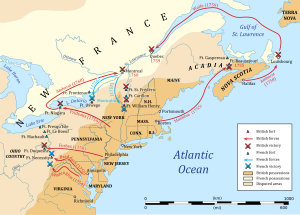| French and Indian War | |||||||||
|---|---|---|---|---|---|---|---|---|---|
| Part of the Seven Years' War | |||||||||
 The war theater | |||||||||
| |||||||||
| Belligerents | |||||||||
| |||||||||
| Commanders and leaders | |||||||||
|
Killbuck Shingas Pontiac | |||||||||
| Strength | |||||||||
| 42,000 regulars and militia (peak strength, 1758)[1] | 10,000 regulars (troupes de la terre and troupes de la marine, peak strength, 1757)[2] | ||||||||
| Casualties and losses | |||||||||
| Unknown | ||||||||
The French and Indian War (1754–1763) was a theater of the Seven Years' War, which pitted the North American colonies of the British Empire against those of the French, each side being supported by various Native American tribes. At the start of the war, the French colonies had a population of roughly 60,000 settlers, compared with 2 million in the British colonies.[4] The outnumbered French particularly depended on the natives.[5]
- ^ Brumwell, pp. 26–31, documents the starting sizes of the expeditions against Louisbourg, Carillon, Duquesne, and West Indies.
- ^ Brumwell, pp. 24–25.
- ^ Clodfelter, M. (2017). Warfare and Armed Conflicts: A Statistical Encyclopedia of Casualty and Other Figures, 1492–2015 (4th ed.). Jefferson, North Carolina: McFarland. ISBN 978-0786474707, p 122
- ^ Gary Walton; History of the American Economy; page 27
- ^ "French and Indian War". American History USA. Retrieved 2021-07-07.
